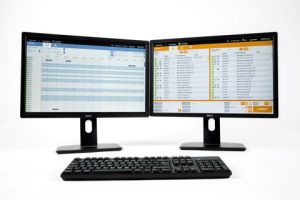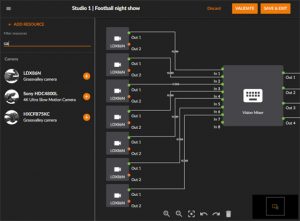SVG Europe Sit-Down: Nevion’s Olivier Suard on remote production and future IP trends
For over 20 years, Nevion has been supplying innovative network and broadcast infrastructure solutions to broadcasters and service providers across the world, to manage and transport professional quality video, audio and associated data, in real time, reliably and securely. Uniquely, Nevion’s IP-based software defined networking (SDN) solutions span both wide area networks (WANs) used in contribution and distribution, and local area networks (LANs) now being deployed in facilities, to help users make the most of IP. We began our Sit Down with vice president of marketing, Olivier Suard, by asking about the company’s vision.

Olivier Suard, vice president of marketing, Nevion
Nevion’s vision is “a world where people have the freedom to create and deliver professional quality content in real time without limitations”. How are you fulfilling that vision?
IP technology is making its way into live production, and it’s much more than a like-for-like replacement of SDI; it’s truly transformational. The reason for this is that IP is ubiquitous, making it much easier for studios, control rooms and production resources, including equipment, to be connected and, more importantly, shared within and across locations. In addition to supporting existing workflows, IP technology, if properly deployed and used, can enable new possibilities for distributed live production, and this is what our vision is about.
To fulfil that vision, Nevion has been architecting solutions that enable virtualisation. The word virtualisation can be taken to mean many things. However, there are two main aspects of Virtualisation. First, infrastructure virtualisation, whereby equipment, and in effect functionality, can be shared across IP networks. And secondly, media function virtualisation, whereby equipment can perform multiple and varied functions thanks to configurable and updatable software.
With that in mind, Nevion is focusing its research and development on software – or media functions, as we call them – and on the ability to route media flows easily through equipment and, indeed, media functions. In addition, we are building up the services broadcasters and service providers need to be able to build the truly flexible infrastructure that will deliver the real potential of IP.
Can you tell us about Nevion’s VideoIPath? What are the benefits to users?

Nevion’s VideoIPath media network management system allows operators to manage every incoming and outgoing signal within an IP infrastructure
VideoIPath is Nevion’s orchestration and SDN management system that allows operators to efficiently manage every incoming and outgoing signal within an IP infrastructure. It is also one of the key building blocks of the move to virtualisation.
Managing an IP media network and orchestrating the signals flowing within it is substantially more demanding than simply managing an SDI network.
An IP media network consists of broadcast and media processing equipment, connected together via a network of generic IP switches. So, the management system needs to be able to handle both broadcast and IP network equipment, from multiple suppliers. The broadcast and media processing equipment will typically be permanently connected to the IP network, so the system needs to establish the logical connections as and when needed, and ensure the signals flow properly between sources and destinations. Furthermore, as IP begins to blur the distinction between LANs used in the facilities and WANs used for contribution or remote production, the management of the media network can no longer be confined to LANs or WANs, but must be fully convergent. And finally, as virtualisation becomes reality, the management system needs to understand software capabilities, and be able to route signals towards the appropriate media functions.
These are challenges addressed by VideoIPath. It is a fully LAN/WAN convergent, vendor agnostic solution, able to handle IP packets and media flows. It provides connectivity with capacity management, including bandwidth, ports, processing capabilities, and can be integrated with control panels, familiar to production professionals. It also offers comprehensive monitoring and analysis capabilities to ensure media service assurance.
And of course, it is designed to handle virtualisation.
Has the increase in remote production impacted the services you offer?

Nevion’s VideoIPath flow app
IP technology is by far the best choice of technology for remote production, and we have naturally seen a steady increase in broadcasters seriously considering the transition to an all-IP future. While our products have not necessarily been impacted – we have been providing IP-based solutions for many years now – we are seeing a rapid increase in the demand for consultative services, for example, helping to get the IP media network architecture and design right. There is now a realisation of the potential of the convergence of LANs and WANs, and so we have been working closely with many customers to build IP networks that can ensure reliable remote production over great distances, sometimes over hundreds and even thousands of miles.
There has been particular interest from large sports broadcasters, who are regularly broadcasting away from the main studio, whether it’s outside a football club’s training ground or the inside of an athletics stadium. The economics of being able to produce sports events centrally are quite compelling. At the lower end, IP remote production means the coverage of smaller sports becomes more viable. At the high end, it means savings can be made to offset some of the costs of the broadcast rights. At the high end, there is also an additional driver – the need to handle an ever-increasing number of feeds and higher resolutions, for example, 4K and HDR. This often requires an upgrade to OB trucks, which can be hugely expensive, and which, in turn, can be used to justify the investment in IP technology.
Where next for IP technology in the broadcast field?
As IP grows to become a fundamental part of modern broadcasting, we will see virtualisation being adopted across the industry. This will bring unprecedented flexibility and cost efficiencies to broadcast production. But that is just the start. Many people who talk about virtualisation will also talk about cloud technology at the same time. At Nevion, we expect aspects of live production to be moved to the cloud – private or public – and be provided as a service to broadcasters. This will be a huge revolution, as broadcasters will effectively outsource their production networks for the first time, enabling them to concentrate on the creation of compelling content.
Where do you think we will be with regards to HDR by the end of this year?
We have certainly seen the competition around HDR image quality pick up in recent months, and it was a hot topic of conversation during this year’s CES show in Las Vegas. However, while it is undoubtedly an interesting and important development in TV technology, we predict it will continue to be overshadowed by the continued adoption of 4K technology and the emergence of 8K in certain countries. While manufacturers have been very quick to bring HDR-enabled displays to market, it seems as though broadcasters are simply too focused on making their offerings 4K compatible, and preparing for the inevitable widespread rise of 8K, to worry about HDR for now. The great news of course is that IP networks will be able to handle HDR, and pretty much any other new image technology. Some upgrade to the network capacity may be needed, but unlike SDI this can be done through the addition, rather than, replacement of switches.
What are your plans for NAB in April?
Nevion will be showcasing its IP media transport and processing solutions for broadcast facilities, contribution, remote production and digital terrestrial, with demos featuring, amongst others, SMPTE 2110 and 2022-6 transport, 4K encoding/decoding (TICO and J2K), and media flow orchestration across IP LANs and WANs.
Do you have an innovative European case study you can share with us?
Last year we worked with broadcaster TV 2, who own the rights to the English Premier League, among others, in Norway, to deliver an IP-based, SDN solution that connects studios, control rooms and data-centres within and between the broadcaster’s two main production facilities. The solution is part of TV 2’s move to IP across the production workflow, and enables the broadcasters to make better use of production talent, equipment and locations. Effectively, it’s an example of infrastructure virtualisation in action.
